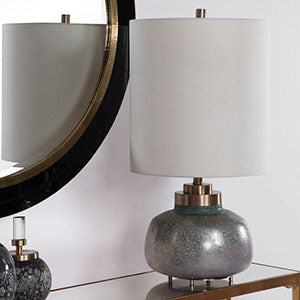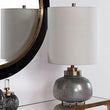Storage & Organization
Easy Home Office Organizing Tips: 7 Decluttering Ideas to Help You Focus
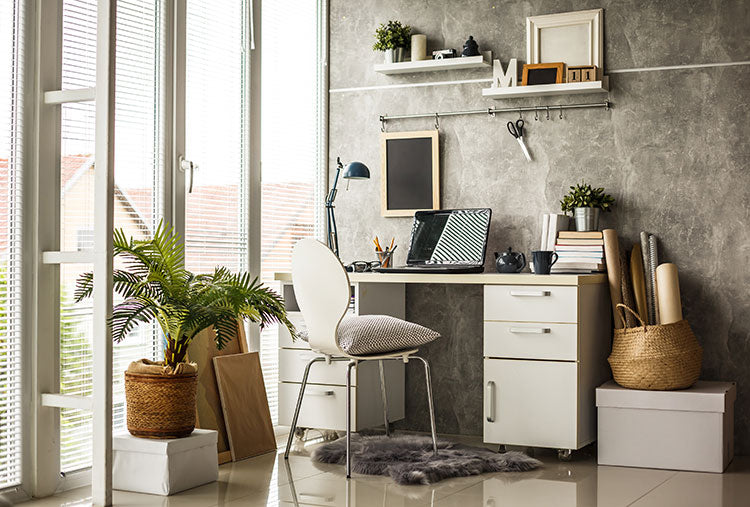
An organized office space improves focus and productivity, whether you're working from home, outlining your budget, planning a vacation, or trying your hand at poetry. Efficiency suffers when cords, pens, and paper clutter your desk or workspace. But, with a few easy steps and décor additions, you can DIY your way to a clutter-free office and streamlined workspace. Explore these 7 tips for creating an organized space and improving focus.
1. Tame Desktop Clutter
The desk—the center of any home office—is a hotspot for clutter and organization woes. With a few easy changes, you can keep everything within easy reach without it getting in the way of your workflow. Make it a habit to put everything away when you're done working so you can start each new day with a clean slate. Try these DIY desk organization ideas:
- Use a floor lamp instead of a table lamp to keep desk space open without losing light.
- Keep pens from rolling around on the desktop by placing extras in a decorative jar or cup.
- Use a monitor stand to get your screen at the right height, and add storage space beneath for pen trays, notebooks, calendars, and small office supplies.
- Choose only desk accessories that inspire or motivate you. An award can remind you of your strengths, while an hourglass keeps you punctual when practicing the Pomodoro Technique—a time management strategy that balances focused work and breaks for improved productivity.
- Go paperless—opt-in for electronic statements and automated payments to keep printed bills from cluttering your workspace. Just add a note to your calendar so you remember to check your statements and balance your checkbook.
Focus on ergonomic desk set-up
If your neck, back, or arms are stiff and sore after a day behind the desk, you may need to make adjustments to the setup. These solutions may help you get more comfortable while you work:
- Use a desk organizer to keep your phone, pens, and regular necessities nearby so you don't have to reach.
- Place your computer monitor directly in front of you, at eye level, to reduce strain and discomfort.
- Adjust your chair so your feet rest comfortably on the floor and be aware of proper posture.
- Some people prefer to stand, rather than sit, while working.
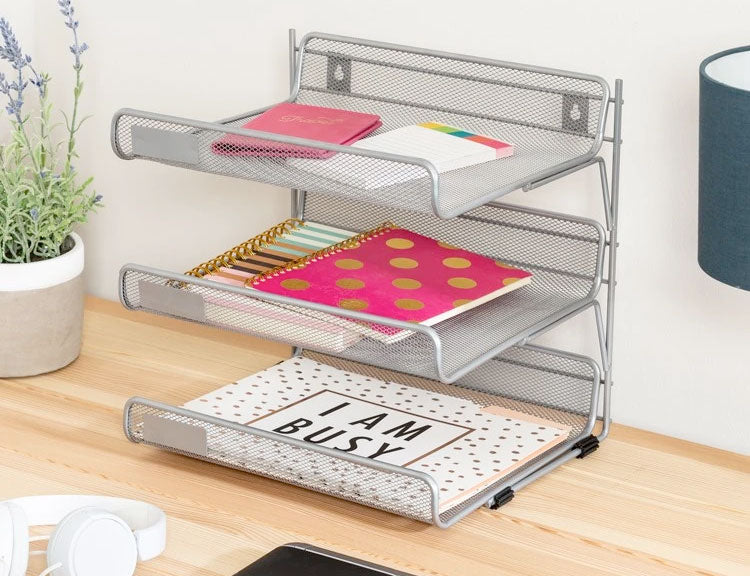
Use a desk organizer to keep your phone, pens, and regular necessities nearby so you don't have to reach.
2. Corral Cords to Cut Down on Clutter
Wrap and secure unused cords with hook and loop strips and use a drawer organizer to tuck cords out of sight. An under-shelf organizer can cradle extra computer cords: Simply secure it to the back of the desk and use it to hold your power strip and coiled cables.
Keep your most-used cables from falling behind the desk with binder clips. Fasten the clip to the edge of the desk and feed the cords through the handle loop. Flip the handles open and the head of the cable will stay put so you don't need to fumble between the desk and wall the next time you need to use a cord.
Finally, ditch extra cords. There's no need to keep a cord for every device if your electronics share the same connection. Keep two or three of each type of cord you use regularly. You can even upgrade your desk with wireless charging stations.
3. Use Shelving and Cabinets for Storage
The essential papers you removed from your desk need storage. File sales receipts, warranties, tax returns, bills, and loan information nearby for easy access. Documents, wills, birth certificates, and marriage licenses are best kept in a safe deposit box.
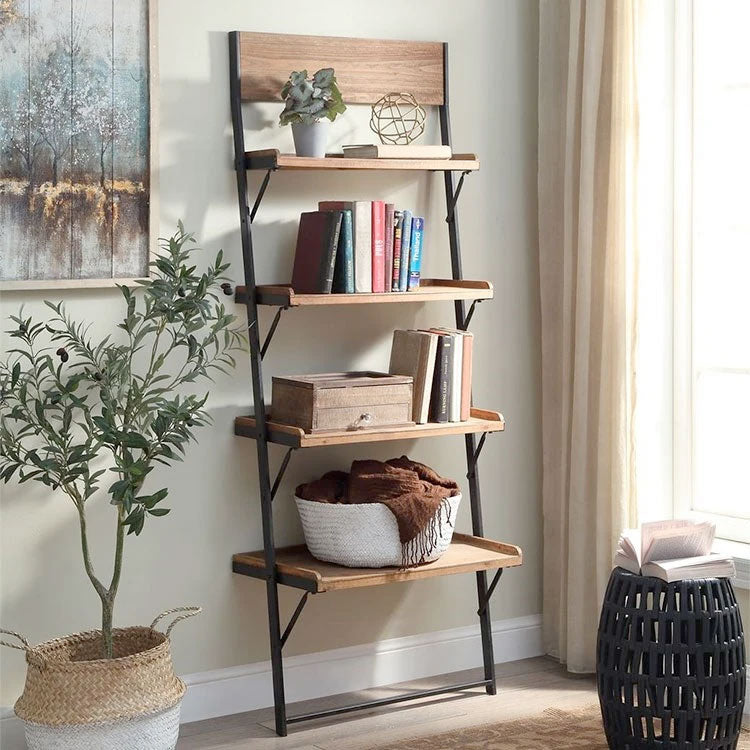
Keep your desk clear and your office organized with decorative shelves.
Explore these solutions for items that can't be filed or discarded:
- Maximize storage with vertical space. Decorative shelves, hanging mail sorters, wall calendars, and pegboard storage solutions keep items within reach.
- Don't forget closet space. Shelves, cabinets, and drawers keep storage spaces organized and conserve space.
- Use a hanging organizer for printer paper, extra file folders, and paper needs, or tuck away crafting supplies to keep them out of sight.
- Dress up cubby-style storage shelves with baskets to match your office theme.
- Use a corner shelf to save space. Built-in shelving above the desk offers room for binders, notebooks, and reference materials while freestanding corner shelves provide an opportunity to show off some décor.
- An attractive sideboard or cabinet offers space to store items behind closed doors—and provides a surface for extra lighting or displaying artwork and decorative touches.
- Add undercabinet lighting to the storage cabinets above your desk for improved light without the need for a desktop lamp.
4. Keep Drawers in Check
Every household has a junk drawer (or more than one). The convenient stash-and-forget-it nature of drawers means these spaces can get cluttered quickly—then ignored. Tackling drawers is a smaller task that offers quick, satisfying results.
Organize your desk drawers in order of importance. Things you're most likely to need (a favorite pen, binder clips, or highlighters), go in the top drawer close to your dominant hand. Drawer organizers keep everything in place and make putting things back more likely.
To start, empty your drawers. (Tip: Make a pile in the center of the room—the visual cue gives you encouragement to complete the project.) Toss anything you don't need, such as old take-out menus, dry highlighters, and used batteries (recycling where you can!).
Next, sort the remaining items by type:
- Pens, pencils, markers, and highlighters can be tucked into a drawer organizer or placed in a desktop pen holder.
- Digitize business cards to free up drawer space and make it easier to track down a specific contact.
- Move loose paper clips, rubber bands, and push pins into small decorative bowls for easy access.
- Round up the loose tape dispensers—keep one in your desk, but tuck the rest into your office supply storage so you can find them quickly the next time you're ready to wrap a gift.
- Organize spare greeting cards by occasion so you can find the right card in moments.
5. Get a Handle on Your Inbox
If your inbox is constantly overflowing, create a system to keep the pile under control. A physical location to put your to-dos and already-dones keeps piles from growing beside your keyboard. A tiered desk organizer provides space to sort as you work. To keep the desktop clear, try a wall-mounted or over-the-door organizer. Then, find an inbox management routine that works for you.
Some people like the one-touch rule. Take care of paperwork right away, rather than shuffling through paperwork multiple times. If the task will only take a few moments, complete it in one sitting rather than leaving it in the inbox for later. Write that wedding date on the calendar, send your subscription confirmation, or sift through and recycle junk mail now, instead of later.
Others prefer to organize tasks in an inbox/outbox format. If this is your style, a step-by-step approach may help move necessary tasks along. Every time you touch an item from the inbox, move it forward. The steps may look like this:
- Open the mail and arrange your bills by due date
- Weekly, or on whatever schedule works for you, schedule or send payments and record the payment
- After the bill is paid, move it to the "done" slot in your file sorter
- Weekly or monthly, file all of the bills from the "done" slot
- Create work 'zones' to improve flow
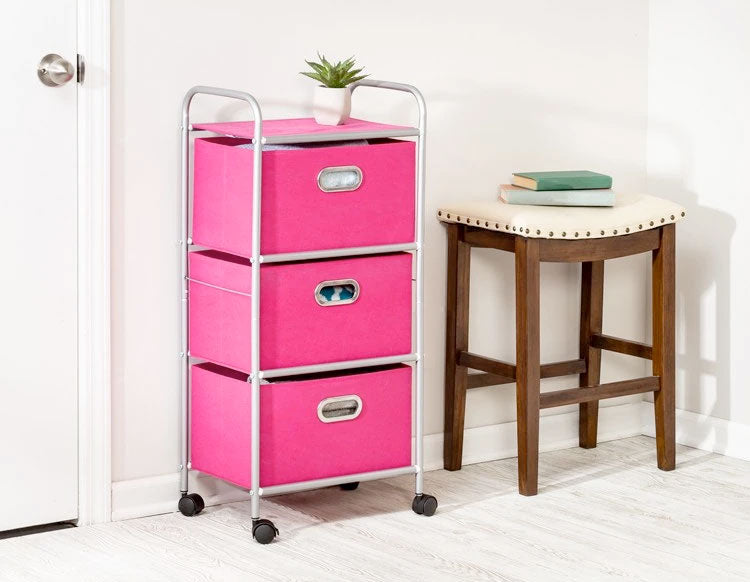
Use a rolling cart to store supplies.
If you're using your home office for a combination of work, bill-paying, crafting, and leisure, create designated spaces so your 9-to-5 doesn't become 24/7. Even if your home office is a work-only, designated areas can increase productivity. Here are some ideas to create distinct zones:
- Use a room divider screen.
- Use two rugs to divide the room visually.
- Use a freestanding open bookcase to divide the space without overwhelming.
- Keep art supplies hidden by installing shelves on the inside of the closet door or using a rolling cart to store tubes of paint, paint brushes, canvases, and craft supplies.
- Create a reading nook with a floor lamp and a comfy chair.
7. Find Fun Elements to Make Small Spaces Work
Clutter-free doesn't mean you must skimp on ornamental items. Décor can be both beautiful and useful. Double-duty items can brighten the office, disguise storage, and provide space that doubles up organization and display.
- Add a decorative chalkboard outside the door for a quick and easy way to let other members of the household know you're hard at work—or open to visitors.
- Convert a wall-mounted wine rack into a throw blanket organizer: Roll throw blankets and nestle them into the curves to keep them out of the way.
- Use decorative bookends to prop up a small collection of your favorite novels or go-to reference material—it keeps the books close at hand, but can also hide unsightly computer cords.
- Attach elastic strips or crisscrossed ribbons across a corkboard, then hang on an open wall to keep favorite photos, invitations, and concert tickets on display, or to tack bills, receipts, and reminders where they remain in sight.
Increase productivity and improve your focus when you declutter your workspace and organize your office. Improve shelving, storage, lighting, and desk organization with these quick and easy DIY solutions.




